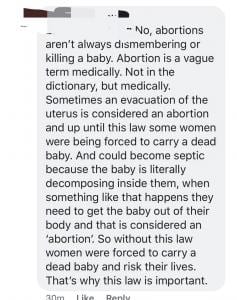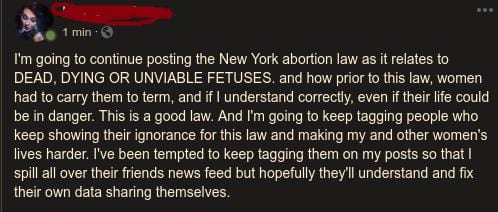Supporters of New York State’s Reproductive Health Act (RHA) claim it was needed because, prior to its passage, New York law required mothers “to carry dead babies to term” or similar verbiage. Here are some examples of these claims that I’ve seen on Facebook:


There are online articles making this claim as well. One example is this piece on Upworthy: “It is possible to be morally pro-life and politically pro-choice at the same time.” In the article, they claim:
I’ve heard too many stories of mothers having to endure long, drawn out, potentially dangerous miscarriages and being forced to carry a dead baby inside of them because abortion restrictions gave them no other choice.
Let’s look the first linked article that allegedly supports this claim, a piece from Vice titled, “I Went to a Catholic Hospital During My Miscarriage—And It Nearly Killed Me.”
The author states she lived in Indiana at the time of the events in question. Here is how Indiana state law defines abortion:
Sec. 1. “Abortion” means the termination of human pregnancy with an intention other than to produce a live birth or to remove a dead fetus. The term includes abortions by surgical procedures and by abortion inducing drugs. (emphasis mine)
Already, there’s something odd about this story. Did the Catholic hospital violate state law by refusing to remove a dead fetus, as this article seems to claim? Let’s find out.
Three paragraphs in, the author says,
When I returned to the ER, I was told that I was having a miscarriage, and that the embryo had stopped growing properly at eight or nine weeks. There was no chance the pregnancy would progress, but the fetus still had a heartbeat. So, despite my worsening condition, I was told to go home and wait. (emphasis mine)
A fetus with a heartbeat is not a dead fetus. Shouldn’t the news that the fetus still has a heartbeat be a welcome one? It means there is still hope! It means that maybe the doctors are wrong that “there was no chance the pregnancy would progress,” given that they have been wrong before.
She continues a little later on,
One of my clearest memories from that day is when I heard the doctor scream, “Who the [censored] sent her home? She could have died.”
I had to have emergency surgery to remove the remaining tissue from my uterus and save my life. The same OB-GYN who gave the order to send me home was still on call when I was brought back in.
I later found out that the doctors at the hospital were not allowed to provide me with the basic care I needed in order to prevent a life-threatening condition because of the facility’s religious affiliation. Someone in my situation should have been offered dilation and curettage—a procedure that removes tissue from the uterus—or another form of miscarriage management.
Doctors are not allowed to kill a living baby just because a miscarriage MIGHT happen. An estimated 50% of miscarriages do not require a D&C, and it’s actually better for a woman to miscarry naturally, as a D&C carries its own risks and potential side effects (such as an increased risk of placenta accreta with subsequent pregnancies).
Hemorrhage such as the author experienced is a risk with any miscarriage, but it is impossible to predict. The initial doctor who saw her may have very well made an error in judgement — there are not enough facts available to determine if that was the case — but he may have judged that she would miscarry naturally on her own and have no complications, as is the case with approximately half of women who miscarry. “Expectant management” is what the American College of Obstetricians and Gynecologists (ACOG) recommends for early pregnancy loss unless there are other factors that indicate medical management is necessary, and bleeding, even heavy bleeding, on its face is not one of those factors.
She’s also wrong when she claims that the Catholic hospital was forbidden from offering miscarriage management. Per the United States Conference of Catholic Bishops in their document Ethical and Religious Directives for Catholic Health Care Services:
47. Operations, treatments, and medications that have as their direct purpose the cure of a proportionately serious pathological condition of a pregnant woman are permitted when they cannot be safely postponed until the unborn child is viable, even if they will result in the death of the unborn child.
If her symptoms had indicated there was a serious risk to her life or health during her first ER visit, they could have taken immediate action, even knowing the baby was still alive.
So, the first article Upworthy offered to support this claim was wrong. It had nothing to do with a woman being forced to carry a dead baby.
Let’s look at article number two, this one from The Daily Beast titled, “Texas Forced This Woman to Deliver a Stillborn Baby.” (Um… isn’t every woman who has a stillborn baby “forced” to deliver him/her, either by nature itself or by medical intervention, whether that constitutes induced labor, C-section, or direct abortion? But I digress…)
This is the first paragraph:
Daniel and Taylor Mahaffey were 20 weeks pregnant and desperately wanted their child, but when doctors informed them a complication meant the fetus had no chance of survival, they just wanted their baby’s suffering to end. Yet because of their state’s “fetal pain” law, the married Texans say they were forced to endure a stillbirth and wait as their baby slowly died in utero.
There are several factual problems with the information offered in this paragraph. The baby had “no chance of survival” and “they just wanted their baby’s suffering to end” — that means the baby was still alive, not dead. This story has nothing to do with being forced to carry a dead fetus.
And why was the baby suffering? Pro-choicers are adamant that fetal pain is a myth perpetuated by pro-lifers — and the article itself says that in the very next line when it decries the Texas fetal pain law! So how exactly was their baby suffering if s/he could not feel pain?
The couple says they were forced to “endure a stillbirth” — well, they would have had to endure a stillbirth regardless, as I mentioned earlier, so this doesn’t really make sense. Instead of hoping that the doctors were wrong, and maybe their baby would miraculously survive — or choosing to cherish the time they had left with their dying child, no matter how long it was — they chose to frame it as being “forced […] to wait as their baby slowly died in utero.” They blame Texas HB2, which has since been overturned, for this circumstance.
The thing is, Texas HB2 had a clause specifically stipulating that the removal of a dead fetus is not considered an abortion:
(1) “Abortion” means the act of using, administering, prescribing, or otherwise providing an instrument, a drug, a medicine, or any other substance, device, or means with the intent to terminate a clinically diagnosable pregnancy of a woman and with knowledge that the termination by those means will, with reasonable likelihood, cause the death of the woman’s unborn child. An act is not an abortion if the act is done with the intent to:
(A) save the life or preserve the health of an unborn child;
(B) remove a dead, unborn child whose death was caused by spontaneous abortion; (emphasis mine)
(C) remove an ectopic pregnancy; or
(D) treat a maternal disease or illness for which a prescribed drug, medicine, or other substance is indicated.
It also said:
Sec. 171.046. EXCEPTIONS. (a) The prohibitions and requirements under Sections 171.043, 171.044, and 171.045(b) do not apply to an abortion performed if there exists a condition that, in the physician’s reasonable medical judgment, so complicates the medical condition of the woman that, to avert the woman’s death or a serious risk of substantial and irreversible physical impairment of a major bodily function, other than a psychological condition, it necessitates, as applicable:
(1) the immediate abortion of her pregnancy without the delay necessary to determine the probable post-fertilization age of the unborn child;
(2) the abortion of her pregnancy even though the post-fertilization age of the unborn child is 20 or more weeks; or
(3) the use of a method of abortion other than a method described by Section 171.045(b).
This was indeed an agonizing experience for them, and I’m genuinely sorry they had to go through it. However, Taylor Mahaffey was not dying or, at that time, physically threatened by the impending miscarriage, and their son, Fox, was fighting desperately to stay with them. His amniotic sac was intact, so this wasn’t a PPROM issue.
What if he’d continued to survive for several more weeks? At 24 weeks, he would have had a decent chance at survival outside the womb. In fact, babies as young as 21 weeks have been saved in the United States — in Texas, no less. Fox Mahaffey was almost at 21 weeks. Although hope was slim, it wasn’t non-existent. Daniel Mahaffey even states that they spent the time while they were waiting “praying for a miracle.” Were the doctors and the state of Texas wrong in holding out hope that this baby could have survived?
So far, the evidence offered by Upworthy fails to demonstrate that women are “forced to carry a dead baby” by anti-abortion laws.
What Do Other State Laws Say?
Let’s look at the laws of other states; specifically, ones that have the heaviest restrictions on abortion.
Iowa
Iowa defines abortion as “the termination of a human pregnancy with the intent other than to produce a live birth or to remove a dead fetus” (emphasis mine).
Mississippi
Mississippi defines abortion as “the use or prescription of an instrument, medicine, drug, or other substance or device with the intent to terminate a clinically diagnosable pregnancy for reasons other than to increase the probability of a live birth, to preserve the life or health of the unborn human being, to terminate an ectopic pregnancy, or to remove a dead unborn human being” (emphasis mine).
Louisiana
Lousiana’s law says (emphasis mine):
§1061.9. Definitions
As used in R.S. 40:1061.8 through 1061.29, the following words have the following meanings:
(1) “Abortion” or “induced abortion” means the act of using or prescribing any instrument, medicine, drug, or any other substance, device, or means with the intent to terminate the clinically diagnosable pregnancy of a woman with knowledge that the termination by those means will, with reasonable likelihood, cause the death of the unborn child. Such use, prescription, or means is not an abortion if done with the intent to:
(a) Save the life or preserve the health of an unborn child.
(b) Remove a dead unborn child or induce delivery of the uterine contents in case of a positive diagnosis, certified in writing in the woman’s medical record along with the results of an obstetric ultrasound test, that the pregnancy has ended or is in the unavoidable and untreatable process of ending due to spontaneous miscarriage, also known in medical terminology as spontaneous abortion, missed abortion, inevitable abortion, incomplete abortion, or septic abortion.
Kentucky
Kentucky’s state law defines abortion as: “the use of any means whatsoever to terminate the pregnancy of a woman known to be pregnant with intent to cause fetal death” (emphasis mine).
If fetal death has already occurred (see the linked definition), it isn’t an induced abortion, and thus is not prohibited.
Missouri
Missouri law says (emphasis mine):
188.015. Definitions. — As used in this chapter, the following terms mean:
(1) “Abortion”:
(a) The act of using or prescribing any instrument, device, medicine, drug, or any other means or substance with the intent to destroy the life of an embryo or fetus in his or her mother’s womb; or
(b) The intentional termination of the pregnancy of a mother by using or prescribing any instrument, device, medicine, drug, or other means or substance with an intention other than to increase the probability of a live birth or to remove a dead or dying unborn child;
Arkansas
Arkansas defines abortion as “the intentional termination of the pregnancy of a mother with an intention other than to increase the probability of a live birth or to remove a dead or dying fetus” (emphasis mine).
Tennessee
Tennessee’s health code defines “induced termination of pregnancy” (which seems to be how they define abortion for statistical purposes) as follows: “the intentional termination of pregnancy with the intention other than to produce a live-born infant or to remove a dead fetus” (emphasis mine).
North Dakota
North Dakota’s abortion law states (emphasis mine):
14-02.1-02. Definitions.
As used in this chapter:
1. “Abortion” means the act of using or prescribing any instrument, medicine, drug, or any other substance, device, or means with the intent to terminate the clinically diagnosable intrauterine pregnancy of a woman, including the elimination of one or more unborn children in a multifetal pregnancy, with knowledge that the termination by those means will with reasonable likelihood cause the death of the unborn child. Such use, prescription, or means is not an abortion if done with the intent to:
a. Save the life or preserve the health of the unborn child;
b. Remove a dead unborn child caused by spontaneous abortion; or
c. Treat a woman for an ectopic pregnancy.
What About New York State?
Did New York State previously have laws that forced a woman to “carry a dead baby”? Not according to Snopes.com. The previous law prohibited abortion after 24 weeks even if the fetus was “unviable.”
“Unviable” does not mean “dead.” It means “unable to live outside the womb.” The baby was still alive within the mother’s womb; s/he was, however, not expected to live long after birth. A woman wasn’t denied removal of a dead fetus; she was simply denied the “right” to kill a living one. Sadly, that has now changed, and abortion is legal at any stage of gestation for any reason.
Please don’t bother to comment to tell me that I’m wrong and abortion is prohibited unless needed to preserve the “life or health” of the mother. I’ve read the law, and I know that the definition of health being used — the one found in Doe v Bolton — is so vague as to be meaningless, and the abortion practitioner who benefits financially from the abortion is the one to make that judgement call. In other words, no “health” reason will ever be judged insufficient at any stage.
Conclusion
The evidence I’ve provided proves without question that even the U.S. states with the most restrictive abortion laws each have provisions making an exception in the case of missed miscarriage, fetal death, or fetal demise.
This is a very personal subject for me because I’ve experienced missed miscarriage three times, all at 12 weeks; once in North Dakota and twice in Arizona. I’ve written about my experiences here and here. My child Jude, lost on October 28, 2015, is pictured in the featured image on this piece; an ultrasound at 12 weeks during a routine prenatal appointment was the one at which we learned of his/her death.
I decided to write this article because I am sick and tired of abortion “rights” advocates telling lies to advance their agenda. It is not right to use my personal pain and tragedy, as well as the pain and tragedy of others who’ve suffered similar losses, to push for the “right” to kill a healthy unborn child. If you are doing this, please stop. If you are sick of others claiming this, please share.












